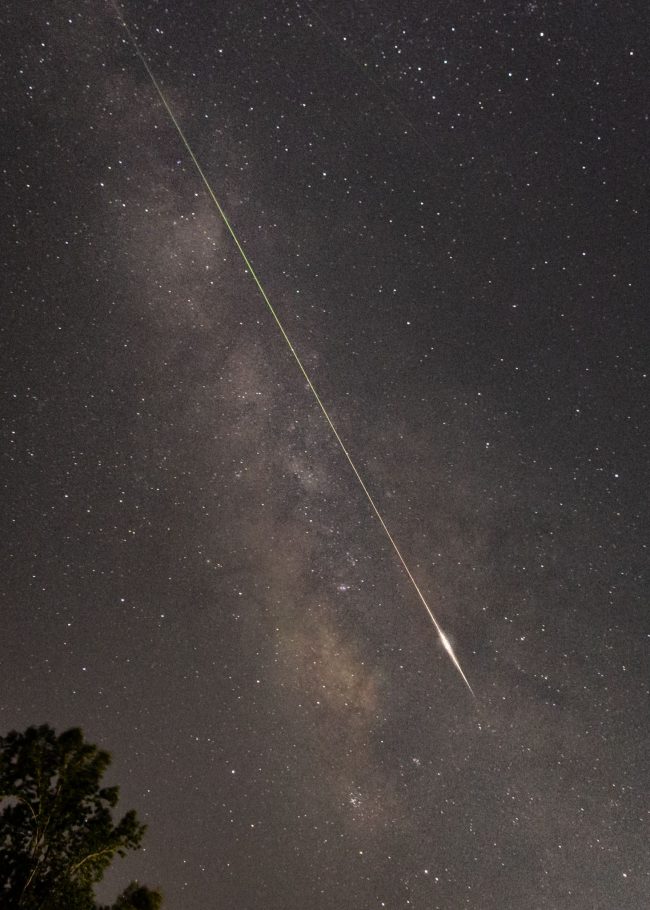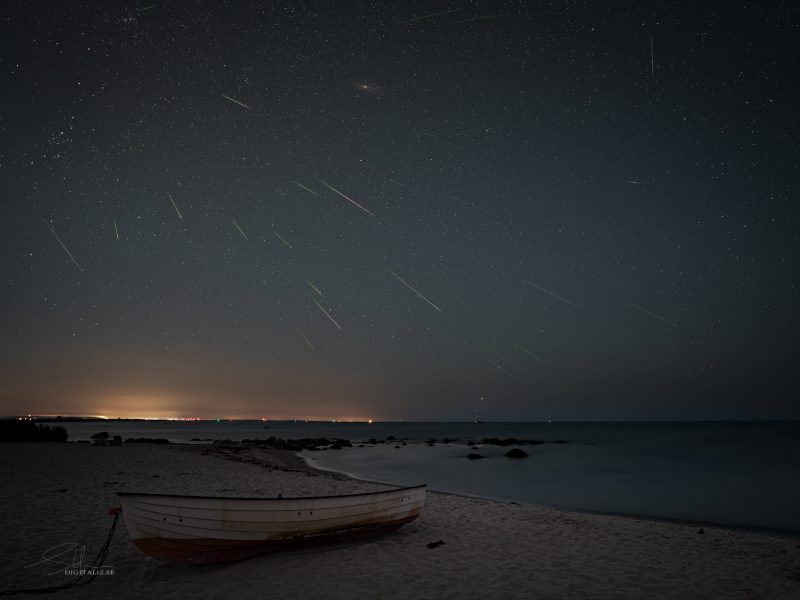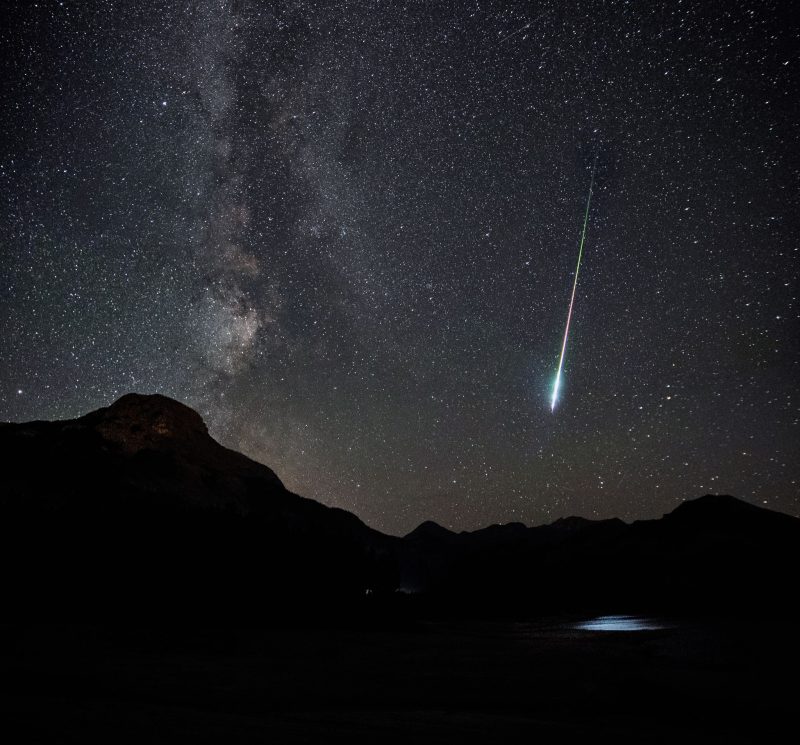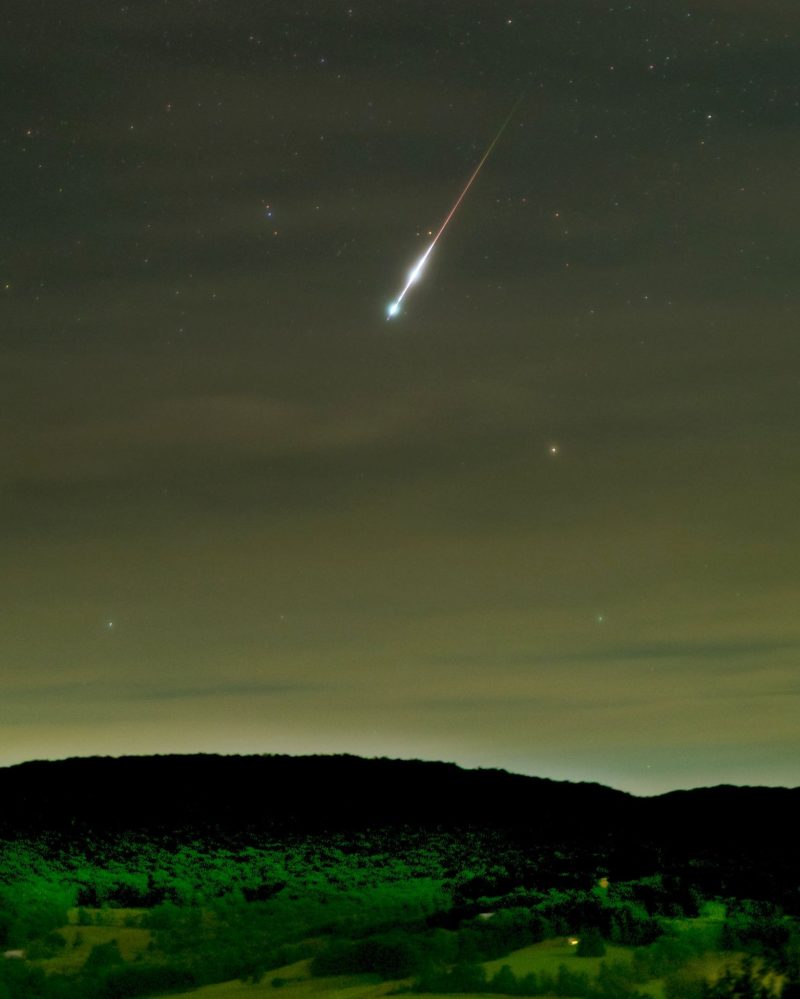
Meteor showers were linked to the orbits of comets in the late 1800s. A comet leaves behind a trail of meteoroid particles no bigger than a tiny grain of sand as it orbits the sun. As the Earth passes through the orbit of a comet, these meteoroids collide with our atmosphere and the resulting friction heats them to the point where we see them streak across our sky.
Meteor showers can have a broad range, slowly rising to a maximum peak and then falling off again; or they can be over in a matter of hours. The meteors from a shower have a wide range of velocities determined by how fast the meteoroid particles are traveling through space. Meteors in a shower can range in brightness from telescopic to fireballs brighter than any planet. There are even meteor showers that peak during the daytime. However, the best time for viewing meteor showers is after midnight through dawn when the night side of the Earth is plowing directly into the path of the meteor shower debris.
Observing meteor showers: What to expect
Meteor showers are wonderful natural phenomena, a chance to commune with the outdoors and see something beautiful. There are several major and minor meteor showers each year. Watching for meteors is a fun and relaxing way to spend time outside enjoying a glorious nighttime sky. Meteor shower observers hope to see the sky rain meteors like hailstones at an apocalyptic rate. You want exploding fireballs, peals of meteoric thunder, celestial mayhem. Well, sadly … that likely won’t happen. Meteor showers are, despite the name, not like a shower of rain. Also some meteor showers are more active than others. A few meteor showers may have only 10 or less meteors per hour. Seeing a meteor rate of one per minute is a very, very good shower.
How can you optimize your chances for seeing the most meteors? Follow the tips below when you venture out to watch a meteor shower!
Tip: Know the peak time of meteor showers
Be sure you know which days the shower will peak. Meteor showers generally happen over many days as Earth encounters a wide stream of icy particles in space. These particles are debris left behind by a comet. The peak is just what it implies. It’s a point in time when Earth is expected to encounter the greatest number of particles from a particular meteor stream. To find the peak dates of meteor showers, try EarthSky’s meteor guide. Be aware that most, but not all, meteor showers are best after midnight.
And here’s the catch … The peak of the shower comes at the same time for all of us on Earth. Meanwhile, our clocks are saying different times. So … pick the optimum time for observing for your location.
Also if a meteor shower lasts a week or more, the days leading up to the peak are a good time to watch meteors, too. You might not see as many meteors. But don’t let that discourage you! The fact is, predictions for meteor shower peaks are not always right on the money. It’s possible to see very nice meteor displays hours before or after the predicted peak.
For example, who can forget the famous 1998 Leonid meteor shower? The predicted peak favored observers in Europe, and yet those of us in the U.S. were nevertheless treated to wonderful displays of Leonids on the nights before and after the predicted peak.
Just remember, meteor showers are part of nature. They often defy prediction.
By the way, different sources might list different times for the peak of a meteor shower. Predictions are not always spot on. Plus, the time of the peak will nearly always be given in UTC so you need to adjust for your local time.
Tip: Location, location, location
Get away from city lights. For optimum viewing, find a dark place to observe in the country.
Give yourself a wide-open view of the sky. A farmer’s field? A stretch of country road? A campsite with a clear view in one or more directions? An open sky will increase your chances of seeing some meteors.
Watch for an hour or more. Meteor showers will be better if you let your eyes adapt to the dark. That can take as long as 20 minutes. Plus the meteors tend to come in spurts, followed by lulls. Be patient! You’ll see some. Several hours per night for several nights will give you the best chance of seeing the best show.
Notice the meteors’ speeds and colors, plus watch for meteor trains. The Leonid meteors seem to zip across the sky, while the Taurids are slow enough everyone can see them when someone yells “meteor!” A meteor train is a persistent glow in the air left by some meteors after they have faded from view. Trains are caused by luminous ionized matter left in the wake of this incoming space debris. Also, some meteor showers are known to be colorful.
Tip: Know where to look around the radiant point
Don’t worry about the radiant point. You don’t need to look in a single direction – or locate the radiant point – to have fun watching the shower. The meteors will appear all over the sky. The radiant point is interesting, though. If you track meteors backward on the sky’s dome, you’ll find them streaming from the radiant point, within the originating constellation. Hence the meteor shower’s name.
Some people seem to think they have to be able to identify the radiant point in order to be able to watch the shower, but that is a serious misconception. If you only watch the radiant point, you will miss a lot of meteors.
You can see meteors shoot up from the horizon before a shower’s radiant has even risen into the sky. Once it has risen into your sky, you’ll see more meteors. When it’s at its highest overhead – assuming you’re watching at a time when the shower has been producing meteors steadily over many hours – you’ll see the most meteors. So find out the radiant point’s rising time. It can help you pinpoint the best time of night to watch the shower.
A word about the expected rate of meteors per hour
Find out the shower’s expected rate, or number of meteors per hour. Here we touch on a topic that often leads to some disappointment, especially among novice meteor watchers. Tables of meteor showers almost always list what is known as the zenithal hourly rate (ZHR) for each shower.
The ZHR is the number of meteors you’ll see if you’re watching in a very dark sky, with the radiant overhead, when the shower is at its peak. In other words, the ZHR represents the number of meteors you might see per hour given the very best observing conditions during the shower’s maximum.
If the peak occurs when it’s still daylight at your location, if most of the meteors are predominantly faint, if a bright moon is out, or if you’re located in a light-polluted area, the total number of meteors you see will be considerably reduced.
Oh no! The moon is out.
Pay attention to the current moon phase. Observing meteor showers is best when you have completely dark skies, so that means no moonlight. Naturally, not all meteor showers will peak near a new moon. If the moon is at a quarter phase or greater, you’re going to miss meteors, even if your skies are otherwise dark. It’s okay if the moon sets before the radiant rises, because the Earth blocks the moon’s light from the sky. But nothing dampens the display of a meteor shower more effectively than the presence of a bright moon.
If the moon is out, you may want to look at areas of the sky away from the moon. Anything in the moon’s vicinity – including meteors – will likely be washed out by its bright light. Another tip for watching in moonlight: place yourself between some object and the moon. Observing from the shadow of a barn, or vehicle, even a tree, can help you see more meteors.
Tip: What to bring? Then relax and enjoy!
Bring along a blanket, a buddy, a hot drink and a lawn chair. You will be more comfortable with a reclining lawn chair. If several of you are watching, take different parts of the sky. If you see one, shout “Meteor!” Let your eyes rove casually in all parts of the sky. Dress warmly; the nights can be cool or cold, even during the spring and summer months. You’ll probably appreciate that blanket and warm drink in the wee hours of the morning. Also, leave your laptops and tablets home; even using the nighttime dark mode will ruin your night vision.
Enjoy nature. Relax and enjoy the night sky. Not every meteor shower is a winner. Sometimes, you may come away from a shower seeing only one meteor. But consider this. If that one meteor is a bright one that takes a slow path across a starry night sky … it’ll be worth it.
To be successful at observing any meteor shower, you need to get into a kind of Zen state, waiting and expecting the meteors to come to you if you place yourself in the position to see them. Or forget the Zen state, and let yourself be guided by this old meteor watcher’s motto:
You might see a lot or you might not see many, but if you stay in the house, you won’t see any.
You can report fireballs if you are lucky enough to see one
By the way, if you’re interested in learning more about meteor showers, or want to contribute meteor counts and brightness estimations, contact the following organizations: The American Meteor Society and the International Meteor Organization. Both provide the latest predictions as well as information to guide you in serious meteor observing.
Photos of meteors and meteor showers from EarthSky’s community
Post your own photos at EarthSky community photos.




Bottom line: Meteor showers are unpredictable but always a fun and relaxing time. Maximize your viewing time with these tips.
When is the next meteor shower? Click here for EarthSky’s meteor shower guide
The post Meteor showers: Tips for watching the show first appeared on EarthSky.
0 Commentaires